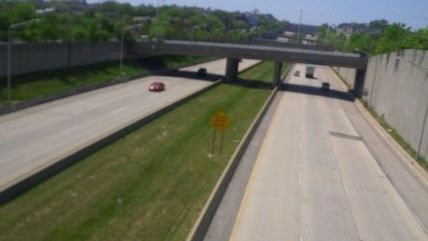The Wound in West Baltimore
How city planners killed a community

A six-lane ditch of a highway runs through West Baltimore. You can enter it heading east on Mulberry Street or going west on Franklin; then you drive a little less than a mile and a half before you have to get off again. You end up on the same street you entered from, just a bit farther up the road. People call it the Highway to Nowhere.
Before that scrap of a freeway was built, the Franklin-Mulberry corridor contained a stable and vibrant black neighborhood. But in the 1960s and '70s, the government made room for the road by destroying 971 homes and 62 businesses. In the process, it displaced around 1,500 people—and destroyed far more property than was burned in Baltimore's riot of 1968.
The immediately defaced area was largely in the neighborhood called Harlem Park, but the effects radiated out much further. The nearby district of Rosemont managed to fend off the wrecking ball, but the fight still inflicted permanent damage: Officials encouraged residents to move, people became unwilling to invest in a place with an uncertain future, neglect settled in, and over the course of the '60s a cohesive black community became, in the historian Emily Lieb's words, "exactly the kind of blighted neighborhood that the roads were supposed to be eliminating." (In 1969, one Rosemont resident wrote to the head of Baltimore's Interstate Division calling the highway "a proverbial pimple on the ass of progress.") "The effects of that little underpass didn't just go into the 300 or 500 block," former resident Alton West told interviewer Andrew Giguere in 2009. "It just spread its wings either way. I guess just call it the domino effect or whatever you want…If the 400 block was affected, now the 3 and the 5 are…and after a while the 600 or the 100….It was like the spread of cancer."
It's certainly possible that these neighborhoods would have undergone a gradual economic decline anyway, given the city's deindustrialization and given that the black middle class soon found it easier to move away. But they would not have undergone such a sudden, severe, and destructive drop. And they would not have been replaced by that trench for cars in the Franklin-Mulberry corridor. The highway has been around for decades now, and it's still doing damage, by severing one section of the city from another and by discouraging any development near it.
All this for a freeway so unnecessary that when it was closed for a spell a few years ago, so a nearby parking lot could be expanded, hardly anyone noticed. "The way the entire expressway was shut down indefinitely without debate or even publicity, just to make it easier for construction crews, speaks volumes," Gerald Neily noted in the Baltimore Brew. "Motorists have been able to make the needed minor adjustments with ease."
What's still stranger is this: If the highway actually did go somewhere, the situation would be even worse.
The authorities had started kicking around plans to bring an east-west expressway to the city in the 1940s. One early proposal came from Robert Moses, the infamous official responsible for ripping out enormous swaths of New York. His scheme would have displaced 19,000 people. That idea didn't prove popular—Baltimore's H.L. Mencken called it "completely idiotic," and a lot of citizens agreed—but similar suggestions circulated throughout the '40s and '50s, backed by downtown businesses and federal dollars. By the early '60s, the government was calling for a new network of highways that would cut through communities across the city. Those plans sparked a grassroots revolt, led by groups with names like RAM (the Relocation Action Movement), MAD (the Movement Against Destruction), and SCAR (the Southeast Council Against the Road).
The larger push was defeated. Some neighborhoods that once had been slated for demolition, notably the harbor-adjacent areas known as Federal Hill and Fells Point, went on to prosper. Parts of the city would even see somewhat fruitful experiments in urban homesteading, though the government mostly stuck to a top-down, crony-capitalist approach to development.
But in West Baltimore, people weren't so lucky: A little piece of the planned network got built. When Harlem Park started to fight the road-builders, the city-wide rebellion against the freeways was just beginning to coalesce. Without as much momentum and militancy as the community groups that matured later, Giguere argues, the Harlem Park activists took a more accommodating approach to the fight: "Rather than protesting the road, the group elected to insure just compensation for those being displaced from the area." They didn't even get that much: The payments that residents received frequently were not enough to purchase a new house elsewhere. But they still took the money and left—they had to, since their homes had been condemned—and the area became a place of trash-filled, rat-attracting vacant lots and abandoned buildings, even before construction of the expressway began.
Most big American cities went through convulsions like this, as slum-clearance and highway projects destroyed working neighborhoods, disrupted people's lives, eradicated ordinary citizens' property rights, and amplified the effects of poverty. Most cities have their counterparts to the other ugly Baltimore stories of the last century too: Jim Crow laws and federally sponsored redlining, corporate welfare and mass incarceration. But if the saga's general contours are not unique, the details in each particular place are. In Baltimore, those details include a ridiculous road on the west side of town, a very short freeway that casts a very long shadow. It's no surprise that Harlem Park was hit hard by the April riot, along with the adjacent neighborhood of Sandtown. The Highway to Nowhere didn't kill Freddie Gray, but it put a poisoned wound in the place where he lived.


Show Comments (54)